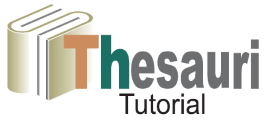Humanities researchers generate, aside from articles and monographs, quantitative datasets holding the empirical results and grounds of their argumentation and proposed theoretic models. The validity of their claims is grounded in empirical datasets that can be understood and questioned by others.
In contemporary information management, the question of how to make datasets FAIR (findable, accessible, interoperable and reusable) has come increasingly to the fore. In order to make research data that will be of use both at present and into the future, humanities researchers must produce data, which meets these criteria. Thesauri generated by researchers play a crucial role in this process.
Thesauri are a proven means to identify documents (e.g. books of interest in a library). The purpose of thesauri in information retrieval is to provide a uniform and consistent vocabulary for indexing documents in information systems and to supply users with a certain vocabulary for the retrieval of documents in such systems. For different domains, different thesauri are available. Even within a single domain, different specialist thesauri may be used.
Since each special field has a terminology of its own, distinct thesauri are useful for individual understanding in each of these fields. In general, it makes sense to use multiple thesauri simultaneously. The interconnection of information systems has increased the significance of thesauri integration. The use of multiple thesauri across multiple databases and systems involves the mapping of the terms and the design of methods to use those terms in indexing and retrieval. Given the large number of thesauri in use across research fields, this amounts to a massive task.





